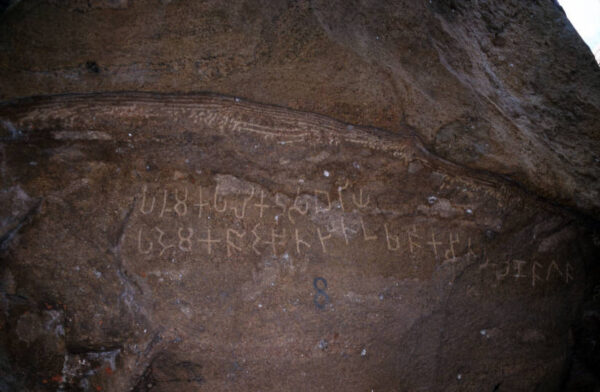Vessagiriya – reminiscent gravity-defying boulder with inscriptions – By Arundathie Abeysinghe

 Located in close proximity to *Isurumuniya, Vessagiriya also known as Vessagiri or Issarasamanarama is an ancient Buddhist Forest Monastery, a section of the ruins of *Anuradhapura. Unlike most historical sites in Anuradhapura, Vessagiriya is a less visited site by tourists. Construction of the Monastery commenced during the reign of King Devanampiyatissa (247 BC – 207 BC) in mid-3rd century BC and the site was expanded during the reign of King Kashyapa (473-495 AD). The Forest Monastery was home to approximately 500 Buddhist Monks and they had lived in rock shelters. Vessagiriya temple complex is located among three rock boulder formations across a large area overlooking the Tissa Wewa in Anuradhapura.
Located in close proximity to *Isurumuniya, Vessagiriya also known as Vessagiri or Issarasamanarama is an ancient Buddhist Forest Monastery, a section of the ruins of *Anuradhapura. Unlike most historical sites in Anuradhapura, Vessagiriya is a less visited site by tourists. Construction of the Monastery commenced during the reign of King Devanampiyatissa (247 BC – 207 BC) in mid-3rd century BC and the site was expanded during the reign of King Kashyapa (473-495 AD). The Forest Monastery was home to approximately 500 Buddhist Monks and they had lived in rock shelters. Vessagiriya temple complex is located among three rock boulder formations across a large area overlooking the Tissa Wewa in Anuradhapura.
Located amongst several mighty boulders, caves, pillars, ponds as well as shady trees, Vessagiriya is a retreat for peace-seeking pilgrims as well as nature lovers as there is a cluster of approximately 50 monastic caves protected by drip ledges hewn out of rock to prevent rainwater from seeping into the caves, considered as an engineering marvel of ancestors. The plaster that had been laid approximately 2,000 years ago exists in patches, to date. On a large cave, there are traces of paintings including the painting of a female figure.
According to scholars, “Vessagiriya” literally means “The rock shelters of the commoners.” Hence, the word “Vessa-giriya” derives from Sanskirit *Vaishya (commoner) and Giri (mountain). Vessagiriya has been a monastic establishment closely associated with Isurumuniya and is considered as one of the most significant monastic establishments dedicated to ascetic Bhikkhus.
History of Vessagiriya dates to 3rd century BC. There are *Brahmi inscriptions on the rock walls inscribed by Bhikkhus, patrons and their lay devotees. According to chronicles 500 Bhikkhus have been ordained as priests at Isurumuniya, *Arhat Mahinda had also ordained 500 Vaishyas at Vessagiriya.
Apart from the drip-ledged caves, there are several significant buildings at Vessagiriya constructed according to traditions of panchavasa (monastic residential complex), ruins of a *Bodhighara, a stupa, a *Chapter House and two cave temples depicting ancient paintings.
There is an inscription in the Temple Complex that leads to ‘Isuru-Meni-Ro-Ipuluwan-Kasumbagiri-Vihara’ adjacent to a granite doorway. According to *Mahawamsa, King Kashyapa (Kashyapa I) has gifted severable lands to Isurumuniya and Vessagiriya and has also constructed a hermitage for Buddhist monks.
Visitors can reach the larger boulders through a rock-hewn staircase that offers panoramic vistas of Anuradhapura. On the summit of the rocks, there are foundations of a small dagoba (stupa) as well as remnants of brick wall structures. Although, the vistas from the rocky cliffs are mesmerizing, it is prudent not to venture closer to the edge of the rocky overlooks that are not
fenced. An inscription belonging to the 6th century AD and the *Jetawanarama slab inscription of King Mahinda IV, a close relationship between Sigiriya and Vessagiriya had existed in the past.
A visit to Vessagiriya yields a spiritual experience regarding ancient Buddhist asceticism as well as an exposure to solitude in a cave retreat. The sedentary lifestyle of ascetic Bhikkhus who embraced the path towards *Enlightenment can be understood after visiting this serene location.

Scholars are of the view that hundreds of ascetic Bhikkhus have dwelt and meditated in Vessagiriya caves, centuries ago.
The trail to Vessagiriya Caves is short and the gravity-defying boulder overhangs are adorned with magnificent vines, some endemic.
Image courtesy – cdl.claremont.edu, findit.lk & stock.adobe.com
- Anuradhapura – A major city in Sri Lanka, the capital of Anuradhapura District.
- Arhat Mahinda – The profoundly sapient Thera arrived in Sri Lanka (former Ceylon) as requested by his father, Emperor Asoka of India (264-267 BC). With the advent of Arhat Mahinda and establishment of Buddhism in Sri Lanka, a socio-religious revolution took place in Sri Lanka changing the life, culture and civilization of people.
- Bodhighara – Bodhighara also spelt “Bodhigara” or “Bodhigaraya” meaning *Bo tree House” was a structure in a temple in which a Bo tree was venerated. Bo trees are an integral part of Buddhist Temples. At present, most of the Bo trees are located on an elevated platform in monastery premises. In a Bodhigara, the Bo tree is surrounded by walls.
- Bo Tree – Also known as Bodhi Tree is a specific sacred fig tree (Ficus religiosa) under which the Buddha had attained *Enlightenment at Bodh Gaya in Bihar, India.
- Brahmi inscriptions – The earliest writing system developed in India after the Indus script and considered as an influential writing system. All modern Indian scripts as well as several hundred scripts that are in South Asia, Southeast and East Asia are derived from Brahmi.
- Chapter House – Chapter House or chapterhouse is a special building from which the rules of the Sangha or the Order of the Buddhist monks was enforced.
- Enlightenment – In Buddhism, Enlightenment is when a Buddhist finds the truth about life and stops being reborn as he/she has reached *Nirvana.
- Isurumuniya Monastery – Situated in close proximity to Tisa Wewa (wewa meaning tank in Sinhala) in Anuradhapura, the Temple had been constructed during the reign of King Devanampiyatissa (307- 267 BC) in 3rd century BC. According to chronicles, the Temple has been constructed by King Devanampiya Tissa as a residence for 500 Bhikkhus ordained at Isurumuniya. Isurumuniya is connected to a cave and there is a cliff above the Temple. The Temple had been constructed as a monastic complex to house newly orientated Buddhist Monks. *Ranmasu Uyana is situated in close proximity to the Temple.
- Jetawanarama – Jetawanarama stupa also known as “Jetawanaramaya” is a stupa (Buddhist reliquary monument) located in the ruins of Jetawana Monastery in the UNESCO world heritage city of Anuradhapura. Constructed during the reign of King Mahasena of Anuradhapura (273–301), according to recorded history, it is the tallest structure in the ancient world and the second tallest non-pyramidal building after Pharos (lighthouse) of Alexandria. The height of the stupa is 122 meters (400 feet) with a base-area of 233,000 m2 (2,508,000 square feet). According historical records, approximately 93.3 million baked bricks had been utilized to construct it. Engineering ingenuity behind the construction of the structure is a significant development in the history of Sri Lanka.
- Mahawamsa – “Great Chronicle” or “Great Dynasty” in Sinhala is the most significant work of Sri Lankan origin written in Pali Language. This Chronicle describes life and times of Sri Lankans from the arrival of Vijaya in 43 BC to the reign of King Mahasena from sixth century BC to fourth century AD. Culavamsa (lesser chronicle) covers the period from fourth century AD to British takeover of Sri Lanka, in 1815. Mahawamsa consists of three parts covering a historical record of over two millennia. It is considered as the world’s longest unbroken historical record.
- Nirvana – Refers to a release from the cycle of death and rebirth, the ultimate spiritual goal of Buddhism.
- Vaishya – The term “Vaishya” was utilized to refer to the class of people in Indian Society who worked in agriculture and trade. The Vaishya comprises commoners from the business and merchant caste.

Ranmasu Uyana – paradigm of garden architecture By Arundathie Abeysinghe – Jan 25, 2021
https://www.elanka.com.au/ranmasu-uyana-paradigm-of-garden-architecture-by-arundathie-abeysinghe/







